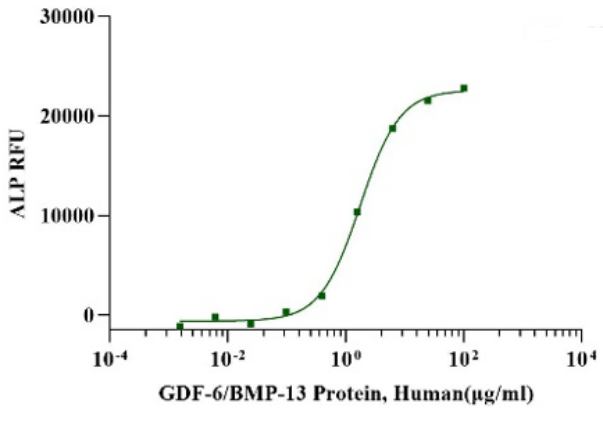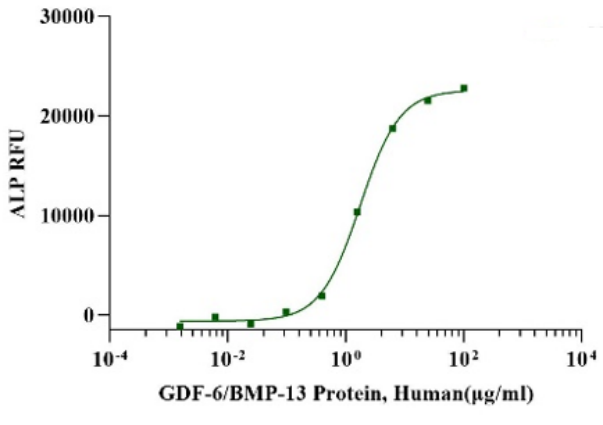Measured by its ability to induce alkaline phosphatase production by ATDC5 mouse chondrogenic cells. The EC50 for this effect is less than 3μg/mL.
Product Details
Product Details
Product Specification
| Species | Human |
| Synonyms | Growth/differentiation factor 6; GDF-6; Bone morphogenetic protein 13 (BMP-13); Growth/differentiation factor 16; |
| Accession | Q6KF10 |
| Amino Acid Sequence | Thr336-Arg455 |
| Expression System | E.coli |
| Molecular Weight | 15-16 kDa (Reducing) |
| Purity | >95% by SDS-PAGE. |
| Endotoxin | <0.1EU/μg |
| Conjugation | Unconjugated |
| Tag | No Tag |
| Physical Appearance | Lyophilized powder |
| Storage Buffer | 4mM HCl |
| Reconstitution | Reconstitute at 0.1-1 mg/ml according to the size in 4mM HCl after rapid centrifugation. |
| Stability & Storage | ·12 months from date of receipt, lyophilized powder stored at -20 to -80℃. |
| Reference | Nature. 1994 Apr 14;368(6472):639-43. |
Background
Growth differentiation factor 6 (GDF-6), also known as bone morphogenetic protein 13 (BMP-13), is a member of the transforming growth factor-beta (TGF-β) superfamily of cytokines that plays a critical role in skeletal development and joint maintenance. In humans, GDF-6 is expressed in various tissues, including cartilage, bone, and synovium, and is involved in regulating chondrogenesis, osteogenesis, and joint homeostasis. GDF-6 exerts its biological effects by binding to specific cell surface receptors, such as the BMP receptors, leading to the activation of downstream signaling pathways, including Smad and non-Smad pathways. Through its signaling activities, GDF-6 promotes the differentiation of mesenchymal stem cells into chondrocytes and osteoblasts, as well as the maintenance of cartilage integrity and joint function. GDF-6 is considered a key regulator of skeletal development and joint health, with implications for musculoskeletal disorders and regenerative medicine.
Picture
Picture
Bioactivity

SDS-PAGE
2μg (R: reducing condition, N: non-reducing condition).


